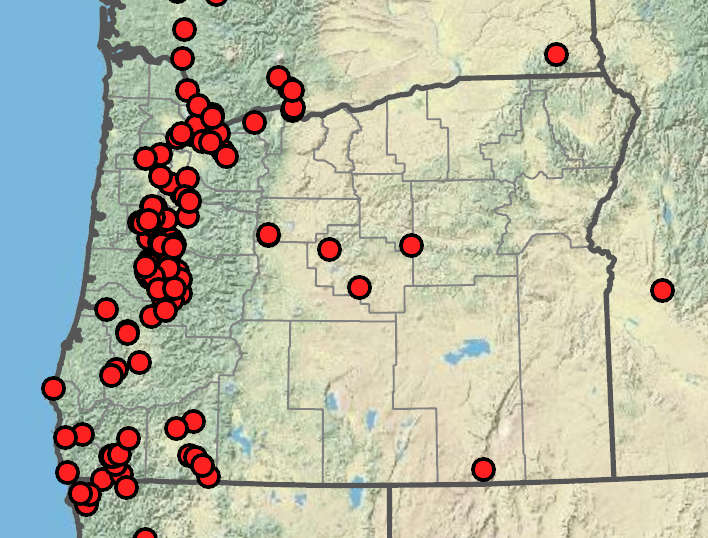Juncus howellii
Juncus occidentalis
Howell's rush
prairie rush, western rush
flat; grass-like, blue-green; up to 4.5 mm wide;
auricles absent or 0.2– 2 mm.
thin and wiry;
blade flat and slightly inrolled;
auricles soft and thin distally, 0.1– 1.1 mm; dull, rounded or acute; dirty white.
(2)5–20 clusters; clusters usually 2–8-flowered.
cymes, 1–7 cm;
bractlets subtending flowers blunt to acute.
tepals 6, dark brown, papillose; inner usually longer than the outer;
stamens 6;
filaments 0.6–1.1 mm;
anthers 1.2–2.6 mm;
styles 1.2–3.2 mm.
tepals 6, brown-striped;
tepal tips acuminate;
stamens 6;
filaments 0.6–1.1 mm;
anthers 0.4–0.9 mm;
styles 0.1–0.3 mm.
obovoid; shorter than the tepals, brown; acute, 3-chambered.
2.7–4.5 mm; shorter than the tepals, brown;
apex usually truncate to slightly notched, strongly ridged or crested distally, 1-chambered.
slender, 0.6–1 × 0.25– 0.3 mm;
body 0.4–0.6 mm; tail 0.1–0.3 mm, 1 or 2 tails at least half the length of the seed body.
0.4–0.6 × 0.2– 0.25 mm, apiculate.
=80.
Juncus howellii
Juncus occidentalis
Springs, gravel bars, wet slopes, peatlands. 600–2200m. BW, Casc. CA, ID, WA. Native.
Auricle characters are occasionally unreliable, so this species is best separated from J. orthophyllus and J. regelii by the intermediate length of the tail on the seed, with one or both seed tails about half as long as the seed body. Juncus orthophyllus has apiculate seeds without a tail, and J. regelii has seed tails approximately as long as the seed body.
Wet prairies, swales, shores, riparian zones, seeps, wet meadows, balds, vernal pools, ditches. 0–2100 m. CR, ECas, Est, Sisk, WV. CA, WA; British Columbia, Baja California Norte, Mexico. Native.
Juncus occidentalis is a western Oregon sister species to J. confusus, separable by the construction of the capsules (threechambered in J. confusus, one-chambered in J. occidentalis).
Peter Zika
Peter Zika
- Local floras:
CA,
OR,
WA
- Local Web sites:
CalFlora,
CalPhotos,
Flora NW,
PNW Herbaria
WildflowerSearch
iNaturalist (observations)
USDA Plants Database
- LBJ Wildflower Center
- SEINet
- Plants of the World Online
- Encyclopedia of Life
- Wikipedia
- Google Image Search
- Local floras:
BC,
CA,
OR,
WA
- Local Web sites:
CalFlora,
CalPhotos,
Flora NW,
PNW Herbaria
WildflowerSearch
iNaturalist (observations)
USDA Plants Database
- LBJ Wildflower Center
- SEINet
- Plants of the World Online
- Encyclopedia of Life
- Wikipedia
- Google Image Search


